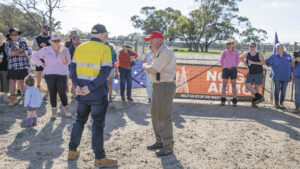
URGENT UPDATE: Australia is facing mounting pressure to accelerate emissions reductions in order to meet its critical climate targets. New reports confirm that the nation is currently on track for only a 42% reduction in emissions by 2030, falling short of the 43% legislated target. With less than a decade to go, experts warn that the 2035 goals, set just months ago, are already in jeopardy.
As of now, Australian emissions are reported at 28% below 2005 levels, with projections indicating a mere 48% reduction by 2035. This is significantly lagging behind the ambitious target range of 62% to 70%. Climate Change and Energy Minister Chris Bowen unveiled these alarming projections during a parliamentary session, emphasizing that while the nation is “close” to meeting the 2030 target, substantial action is required to ensure the 2035 objectives are not missed.
The Department of Climate Change, Energy, the Environment and Water has highlighted the urgent need for tougher climate policies to bridge this widening gap. Minister Bowen stated, “The emissions projections also show additional work is needed to achieve the 2035 target.”
Australia’s climate commitments are part of the Paris Agreement, aimed at preventing dangerous global temperature rises. Following a recent round of United Nations climate discussions, leaders warned that the world is at risk of surpassing the 1.5°C warming limit, which poses increased threats of extreme weather events, including floods and fires, for Australia.
The Climate Change Authority has acknowledged that while emissions are declining, the pace is alarmingly slow. Their report states, “If the 2030 target is to be achieved, the pace of emissions reductions must at least double compared to the average rate achieved in the past five years.”
The electricity sector has been tasked with leading the charge in emissions reductions. Although renewable energy growth is robust, the Labor Government’s goal of achieving 82% clean energy generation by 2030 is at risk of falling short. Recommendations from the Climate Change Authority include expediting the rollout of clean energy initiatives and extending the capacity investment scheme beyond 2027 to ensure continued funding for solar and wind projects.
In a bid to support these efforts, parliament appears to be moving forward on reforming environmental protection laws. A new agreement between the Greens and Labor has been welcomed by the clean energy sector, which has been grappling with stalled project approvals.
Erwin Jackson, head of Australian programs at Climateworks Centre, stressed the need for Australia to move “further and faster” in its climate commitments. He pointed out, “More work is needed, for example, to curb transport emissions and save people money at the bowser,” as transport is on track to become Australia’s largest source of emissions.
Greens leader Larissa Waters criticized the government’s failure to include a mechanism to halt emissions-intensive projects in the newly revised nature laws, calling it a missed opportunity to reduce the substantial gap between the 2035 climate goals and current forecasts. “The Greens stopped Labor’s plan to fast track 30-day coal and gas approvals, but Labor point blank refused to include a climate trigger because they are in bed with the fossil fuel industry,” she stated.
The federal coalition remains skeptical about the government’s energy and climate plan, having opted to abandon the net-zero target altogether. Despite this, Minister Bowen maintains that his policies are effectively driving down energy costs for Australians, particularly through subsidies for household batteries and free solar energy offers during peak sunlight hours.
As Australia stands at a critical juncture, the urgency for faster emissions cuts has never been more pronounced. With climate goals at risk, the time for decisive action is now.





